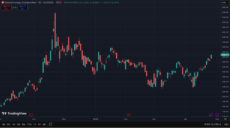Wondering how to buy crypto but not sure where to start? Our beginner's guide explains how and where to invest in digital assets l...
MicroStrategy blends enterprise software with bold Bitcoin bets. Here’s how it impacts MSTR stock.
Key Notes
- MicroStrategy has become the largest corporate holder of Bitcoin, using its treasury to accumulate over 200,000 BTC as part of a long-term strategy.
- The company’s stock (MSTR) closely mirrors Bitcoin’s price movements, making it a proxy investment for crypto exposure.
- Investors remain divided — some see high upside potential tied to Bitcoin’s growth, while others warn of volatility and risk of concentration.
MicroStrategy has become one of the most intriguing investment stories of recent years, merging traditional enterprise analytics with groundbreaking Bitcoin adoption. Investors and analysts alike closely track its stock price, driven not only by MSTR’s fundamental business performance but also by the significant influence of its digital asset strategy.
This comprehensive analysis examines MicroStrategy’s recent stock movements, financial health, technical indicators, analyst forecasts, and the significant impact of its Bitcoin holdings, providing investors with crucial insights for informed decision-making.
Introduction to MicroStrategy Incorporated
MicroStrategy Incorporated, founded in 1989 and is headquartered in Tysons Corner, Virginia, develops and sells enterprise solutions that include software platforms, mobility software, cloud-based subscriptions, and related services. The firm designs sophisticated software platforms tailored to enhance decision-making across various industries, including finance, retail, and healthcare. By offering integrated product packages through licensing arrangements and ongoing services, MicroStrategy delivers comprehensive value to its global client base.

Old Logo. Photo: MicroStrategy Official Website.
Its business strategy focuses on generating steady revenue streams through licensing arrangements and cloud-based subscriptions. Regular updates in the MSTR’s earnings reports, comparing actual estimates to projections, are closely monitored by investors. Although MicroStrategy does not emphasize dividends, its yield occasionally draws attention, especially among income-focused market participants.
In February 2024, MicroStrategy announced its rebranding to Strategy, marking a significant shift beyond traditional business analytics toward a broader focus on digital assets. The new name reflects the MSTR’s commitment to innovation, strategic capital management, and integrating blockchain technologies into its enterprise solutions.

New logo. Photo: Strategy Official Website.
Company Overview
Initially renowned for its business intelligence and analytics solutions, MicroStrategy sells software platforms that allow enterprises to analyze large volumes of data efficiently. Over the decades, it has established itself as a trusted provider to Fortune 500 companies, with a strong presence in sectors such as finance, healthcare, and retail. Its portfolio continues to expand with mobility software innovations and cloud-based subscriptions, reinforcing its leadership in enterprise analytics.
Transition to Bitcoin Investment
In a landmark decision in August 2020, MicroStrategy shifted its treasury strategy by investing heavily in Bitcoin, making it the first publicly traded firm to do so. CEO Michael Saylor spearheaded this bold move and has since significantly influenced the stock’s behavior, particularly in pre-market activity. The MSTR’s Bitcoin acquisition strategy has redefined its corporate identity, positioning MicroStrategy at the forefront of integrating digital assets into traditional financial models, while maintaining its core focus on selling software platforms and related services.
Current Stock Performance
MicroStrategy’s stock has drawn substantial investor attention, primarily driven by its strategic Bitcoin investments and its underlying enterprise analytics business. The stock’s performance increasingly mirrors movements in Bitcoin’s price, creating a unique dynamic in the financial markets.
Recent Price Movements
In recent months, Strategy’s stock price exhibited considerable volatility, largely tracking fluctuations in the cryptocurrency market. Significant Bitcoin rallies typically propelled MicroStrategy shares upward, reflecting investors’ optimism regarding digital asset investments. Conversely, corrections in Bitcoin’s price prompted sharp downturns in MicroStrategy’s valuation, highlighting the stock’s increased sensitivity to crypto market sentiment.

MSTR Price Chart. Photo: TradingView.
Despite the inherent volatility, the overall trend remains bullish, as long-term investors see value in MicroStrategy’s substantial Bitcoin holdings and ongoing enterprise business operations.
Market Cap and Trading Volume
As of early 2024, MicroStrategy maintained a market capitalization exceeding several billion dollars, placing it among notable mid-cap technology firms. The MSTR’s Bitcoin-driven narrative has led to increased trading activity, often pushing its daily trading volume above historical averages. Periods of increased cryptocurrency market activity often lead to surges in MicroStrategy’s trading volume, underscoring the stock’s appeal as a proxy investment for exposure to Bitcoin.
This consistent trading activity highlights robust investor interest, making MicroStrategy a prominent stock in discussions surrounding the convergence of traditional markets and cryptocurrency investment strategies.
MSTR Earnings and Financial Health
Analyzing MicroStrategy’s financial health provides valuable insights into its ability to balance the core analytics business with the strategic allocation toward Bitcoin. A careful look at revenue trends, profitability, and overall liquidity is essential for understanding the MSTR’s current position and prospects.
Revenue and Net Income
In recent quarterly reports, MicroStrategy demonstrated relatively stable revenue streams from its core software and analytics solutions. The MSTR’s analytics division consistently generates steady cash flow, driven by established long-term contracts with enterprise clients. However, net income has experienced fluctuations, primarily influenced by significant accounting adjustments tied to its extensive Bitcoin holdings. As Bitcoin prices vary, these adjustments can cause considerable swings in reported earnings, reflecting unrealized gains or losses.
Despite short-term volatility, MicroStrategy’s underlying business operations remain solid, continuing to generate reliable revenues independent of its Bitcoin investments.
Cash Flow and Balance Sheet
MicroStrategy maintains a unique balance sheet characterized by substantial Bitcoin holdings. The MSTR actively leverages debt financing, including convertible notes, to expand its cryptocurrency reserves. This strategic approach significantly impacts liquidity metrics, reflecting sizable digital asset positions against corresponding liabilities.
Cash flow statements have shown notable variability, driven predominantly by investment activities involving Bitcoin acquisitions and occasional divestments. However, it remains healthy due to consistent earnings from the core analytics business, which provides necessary support for ongoing operations and strategic initiatives. The dual-nature balance sheet, with traditional assets complemented by digital currency, positions MicroStrategy Incorporated distinctly among publicly traded companies, reflecting a pioneering approach to corporate treasury management.
Analyst Forecasts and Price Predictions about MSTR Shares
Market analysts closely monitor MicroStrategy’s performance, offering valuable forecasts that help investors anticipate future price movements. Short-term and long-term predictions provide distinct perspectives on the company’s potential trajectory, which are significantly influenced by cryptocurrency market dynamics.
Short-Term Predictions
According to recent analyst consensus, MicroStrategy’s stock is anticipated to experience a short-term decline, with forecasts indicating a potential decrease to approximately $286.30 by May 19, 2025. This represents a projected change of around -9.74% from current levels. Prominent analytics platforms, including Zacks, CoinCodex, and StockInvest, highlight caution due to expected near-term volatility, closely linked to Bitcoin’s price fluctuations and broader market sentiment.
Long-Term Outlook
Looking further ahead, long-term analyst projections paint a more balanced picture. Forecasts for 2025 suggest that MicroStrategy’s stock price could trade within a range of $284.69 to $351.59, reflecting varied sentiment around cryptocurrency market adoption and regulatory conditions.
Beyond 2025, forecasts become increasingly optimistic, especially towards 2030, driven by expectations of sustained Bitcoin adoption and MicroStrategy’s ongoing strategic investments in digital assets. Analysts from CoinCodex indicate a potential for significant appreciation, provided the company’s core analytics operations remain stable and cryptocurrency markets continue to mature.
Technical Analysis
Technical analysis offers investors important insights into MicroStrategy’s price trends and potential future movements. By evaluating key technical indicators and identifying critical support and resistance levels, investors can better understand the stock’s trading patterns and likely direction.
Key Indicators
Examining moving averages reveals important signals regarding MicroStrategy’s current price momentum. The 50-day Simple Moving Average (SMA) currently stands at $296.97, while the 200-day SMA is significantly higher at $431.92. This substantial gap between short-term and long-term moving averages indicates a prevailing bearish trend, suggesting cautious sentiment among traders.
Typically, a stock trading below its 200-day simple moving average (SMA) is viewed as experiencing downward momentum, while movement around the 50-day SMA often signals shifts in near-term market sentiment.
Support and Resistance Levels
Technical levels also provide valuable benchmarks for price action. Critical support levels for MicroStrategy are identified at $296.86 and $250.51. These points represent areas where historical buying activity has frequently occurred, potentially stabilizing the stock price during periods of decline. If the price breaches these support levels, it could lead to further downward pressure.
Conversely, resistance levels are established at $335.72 and $383, marking significant barriers the stock has struggled to surpass recently. A decisive breakout above these resistance points could indicate renewed bullish momentum, attracting fresh investor interest and potentially driving the price upward. Traders closely watch these levels to identify possible entry and exit opportunities based on the stock’s behavior around these critical price zones.
Impact of Bitcoin Holdings
MicroStrategy’s strategic move into Bitcoin has profoundly reshaped its corporate identity and investor perception. As one of the largest institutional holders of Bitcoin, the company’s financial performance and stock behavior are now intricately tied to the cryptocurrency’s market movements.
Bitcoin Acquisition Strategy
Under the leadership of CEO Michael Saylor, MicroStrategy launched an aggressive Bitcoin acquisition strategy in August 2020. The company consistently leverages cash reserves, debt issuance, and equity financing to increase its Bitcoin holdings, viewing the cryptocurrency as a superior long-term store of value and hedge against inflation. This bold approach positions MicroStrategy as a pioneer among publicly traded companies embracing digital assets as core treasury holdings.
Correlation with Bitcoin Price
Strategy’s stock price now exhibits a strong correlation with Bitcoin’s market performance, acting as a proxy investment for cryptocurrency exposure. Periods of Bitcoin appreciation typically translate into positive movements for MicroStrategy shares, as investors price in higher unrealized gains from Bitcoin holdings.
Conversely, downturns in the crypto market directly impact MicroStrategy’s stock valuation, increasing volatility and highlighting the heightened risk profile associated with its significant cryptocurrency exposure. This correlation underscores the importance for investors to closely monitor Bitcoin price trends when assessing MicroStrategy’s stock potential.
Disclaimer: This article is for informational purposes only and does not provide financial, trading, or investment advice. Cryptocurrency prices can fluctuate wildly, so always do your own research (DYOR), assess risks, and consult a professional before making financial decisions. The author and team are not responsible for any losses from using this information.
FAQ
What is the current stock price of MicroStrategy?
MicroStrategy’s stock currently trades around $317.20, with recent volatility closely tied to Bitcoin’s price movements.
How has MicroStrategy's investment in Bitcoin affected its stock performance?
MicroStrategy’s substantial Bitcoin investment has significantly increased its stock volatility, making it heavily dependent on cryptocurrency market trends.
What are analysts' short-term and long-term price predictions for MSTR?
Short-term forecasts anticipate a decrease to around $286.30 by May 19, 2025 (-9.74%), while long-term projections for 2025 suggest a price range between $284.69 and $351.59, with potential growth into 2030.
How does MicroStrategy's financial health impact its stock valuation?
MicroStrategy’s stable analytics business supports consistent revenue, though its Bitcoin-driven balance sheet volatility strongly influences investor perceptions and overall stock valuation.
What are the key technical indicators to watch for MSTR?
Investors should monitor the 50-day SMA ($296.97) and the 200-day SMA ($431.92), as their divergence indicates current bearish sentiment and potential resistance levels.
How does the company's Bitcoin holding strategy influence investor sentiment?
MicroStrategy’s aggressive Bitcoin acquisition approach attracts investors seeking cryptocurrency exposure, yet also raises risk awareness due to potential price volatility.
What are the potential risks associated with investing in Strategy stock?
The primary risks include extreme volatility linked to Bitcoin prices, regulatory uncertainty surrounding cryptocurrencies, and substantial debt incurred from funding Bitcoin acquisitions.
How does MicroStrategy's stock compare to direct Bitcoin investment?
While MicroStrategy provides indirect exposure to Bitcoin, its stock carries additional corporate risks and complexities compared to direct cryptocurrency investment.
What support and resistance levels are critical for MSTR's stock?
Critical support levels are at $296.86 and $250.51, with key resistance identified at $335.72 and $383; movements beyond these points could significantly influence future price trends.
How do market trends and Bitcoin price fluctuations affect MSTR's future outlook?
MicroStrategy’s outlook heavily depends on Bitcoin’s performance and broader market sentiment; bullish crypto cycles generally enhance its valuation prospects.
Coinspeaker in Numbers
Monthly Users
Articles & Guides
Research Hours
Authors
We’ve spent weeks analyzing LivLive’s whitepaper, presale data, and community sentiment to come up with our honest take on where L...
In this article, we examine whether Super Pepe is a legitimate opportunity or a potential scam, highlighting its charity-focused m...
 9 mins
9 mins
Tony Frank
Crypto Editor, 52 postsTony Frank is an accomplished cryptocurrency analyst, author, and educator whose work bridges the gap between complex blockchain technology and accessible, actionable insights for global audiences. Over the past decade, he has emerged as a respected voice in the rapidly evolving world of digital assets, combining technical expertise with a talent for storytelling to help readers navigate everything from Bitcoin’s monetary philosophy to the intricacies of decentralized finance (DeFi). Tony earned his Bachelor’s degree in Economics and Finance from the University of Melbourne, where he developed a deep interest in monetary systems and market structures. He later pursued a Master’s degree in Blockchain and Digital Currency from the University of Nicosia, one of the first academic institutions to offer accredited programs in cryptocurrency studies. Before focusing full-time on blockchain, Tony worked as a financial analyst for a multinational investment firm, covering emerging technologies and alternative asset classes. His early exposure to macroeconomic policy, global market behavior, and fintech innovation laid the foundation for his later work in crypto research and writing. Tony’s expertise spans multiple sectors of the blockchain industry, including cryptocurrency fundamentals, altcoin market cycles, DeFi and web3 trends and regulatory landscapes. Tony combines on-chain data analysis with macroeconomic research, providing readers with both the technical “how” and the market “why” of cryptocurrency movements.